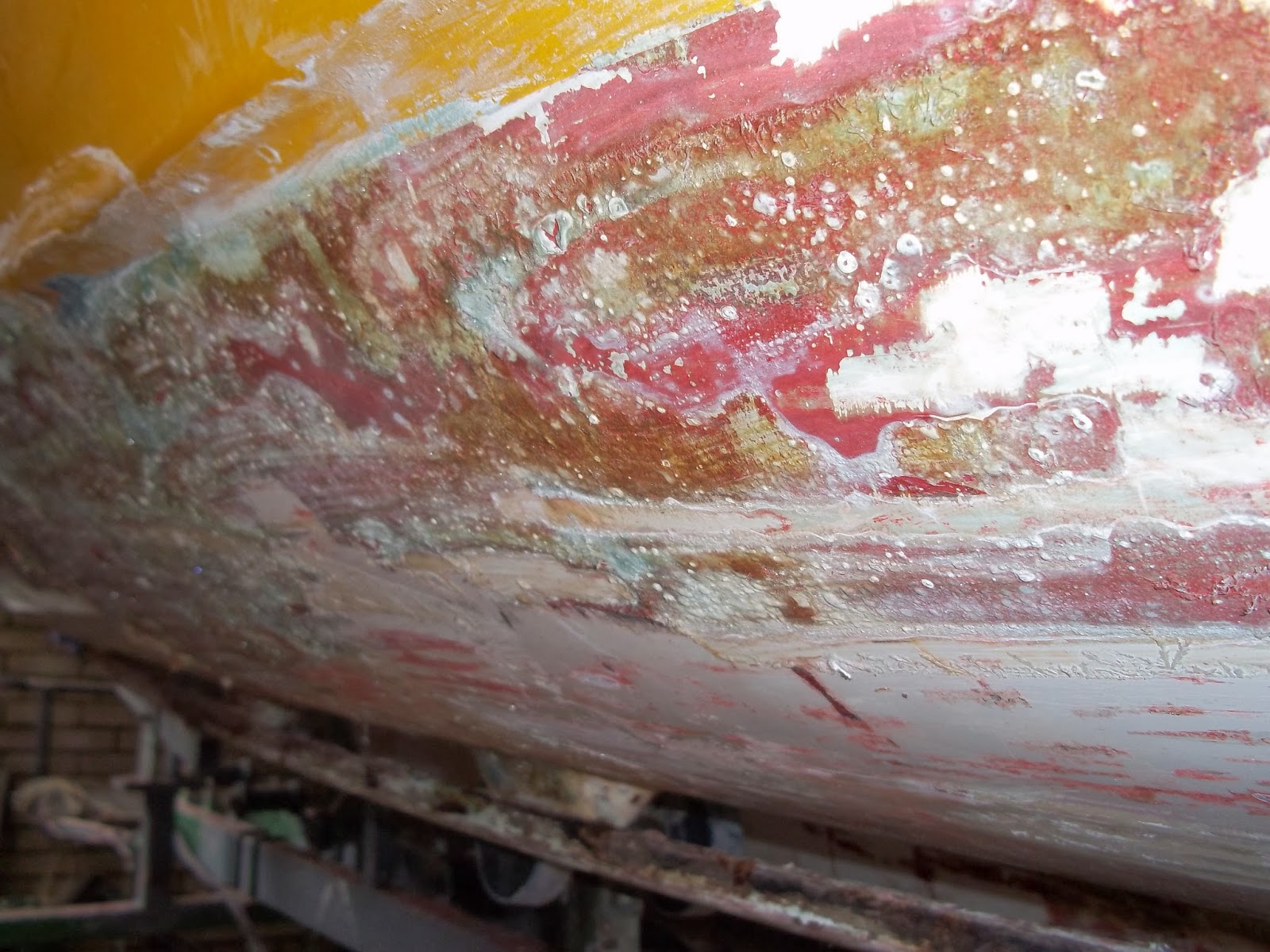When purchased,
Tra Bhui came coated with years of antifouling which not only did it not follow
the waterline, had a very rough finish and displayed various colour and texture
variations as a result of the care and extent to which each subsequent layer
had in the past been prepared for and applied.
This detracted
from the boats appearance and potential performance - if the Americas Cup
racers polish their boats to maximize their performance why shouldn’t Drascombe
owners? But did it hide any botched repairs or other damage?
Picture showing
original antifouling – area scraped with Stanley Knife blade to see what lies
below
Investigation
Careful scraping with a Stanley knife blade
proved that the antifouling was hard
and while in places brittle was generally well bonded to the hull.
Investigation also uncovered a layer of red paint underlying the antifouling.
The good news was that underneath 17 years of antifouling and paint the
original white gel coat appeared to be in excellent condition.
Removal
options
Having
considered various means of removing the antifouling
·
Mechanical scraping (sanding)– would be messy, time
consuming and may damage the gel coat should the antifouling vary in thickness
·
sandblasting while cheap would
potentially damage the gel coat,
·
soda blasting which would
potentially give the best finish of any blasting technique was too expensive (I
could have bought a boat for the cost of the cheapest quote!)
·
water / bead blasting again too
expensive and could not guarantee the quality of finish
·
chemical stripping – while
potentially the cheapest option it would be a suck it and see approach
I decided that
chemical stripping was the best option.
Having carried
out a bit of online research about what chemical to use I chose Owartol which
comes in 1 litre containers. The method is to apply the stripper - which comes as a
thick liquid - by brush, leave it for at least 12 hrs and then wash it off
using a pressure washer (hot
water would also help).
Based on a number
of trial areas it was obvious that the thicker the stripper was applied the
more effective it was and that no matter how thick it was applied and how long
it was left for, the antifouling would not wash off!
Process
The best
solution appeared to be to apply a liberal layer of Owartol, leave it 12hrs to
24hrs and then to use a scraper with a Stanley knife blade (sold in most DIY
stores to remove paint from glass when painting windows) to gently remove the
antifouling. As Tra Bhui had years of antifouling, not to mention the
underlying paint coat, up to three applications of stripper was required until
the gel coat was exposed. The number of applications is more reflective of the
thickness of antifouling rather than the effectiveness of the Owartol.
Picture showing hull
during second / third application of Owartol
Unfortunately mid way through the stripping
process was the last Drascombe Association Rally that we would be able to
attend in 2013. As we had never really explored Norfolk nor had we sailed on
the Broads and keen to sail again before I was due to return to work overseas,
we trailed a very sad looking boat 400 miles south, hoping that it would not
look too bad once it was in the water!
Having stripped
the whole hull (using 4 litres of Orwartol) I was left with a blotchy but fully intact white gel
coat. The blotches were red and appear to have been a consequence of the
original painting of the hull below the waterline.
To remove the
blotches the whole area which had been stripped was sanded with using 120 and
200 grade sand paper, before being rubbed down with wire wool (Brillo Pads) and
again with nylon pan cleaners. This brought the original gel coat back to
nearly its former glory albeit with an unpolished surface.
Picture showing hull after sanding
with 200-grade sandpaper
The next step
was to “cut” the gel coat back using a cutting compound and a 1200watt power
buff.
After “buffing”
the hull was polished with a high gloss polish suitable for fiberglass.
Although 98% of the hull is now stripped and polished, there are small areas
next to and under the Chine Rails, which are hard to get at. As I plan to
replace the Chine Rails shortly I will finish these areas when they are removed.
Picture showing Tra Bhui being
taken off its trailer to allow the hull to be power buffed
Summary
Removing Anti- fouling was a
relatively simple but messy job, especially on a Drascombe when you have to lie
under the boat to do it! The Owartol worked well when applied thick enough. If
you simply wanted to re apply antifouling there would be no need to go to the
lengths I went to reinstate the original gel coat. The finished hull surface is pretty much as
good as new given that the boat is now some 17 years old
The other good news that apart from a
very minor historic repair at the bottom of the rudder casing there was no
damage to the hull at all. The small repair that is there has not been very
well carried out so I will remove it and properly repair the small damaged area
when I replace the hull timbers.
Picture of finished hull after
power buffing




